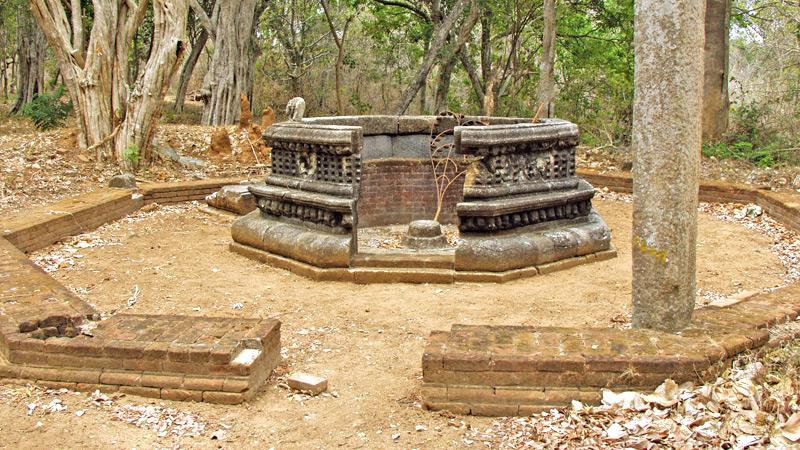
Migahajadura is a serene farming village in the northern part of the Hambantota district. Although it is not yet nine in the morning, the sun is hot and beating down upon the vast stretch of green paddy-fields and chena sprawled in all directions. A little beyond the quaint village of Migahajadura is our destination, Mahagal Wewa, where the historic Padikemgala Raja MahaViharaya rises majestically against the backdrop of the lush greenery in the Walawe basin.
 I have visited the Padikemgala Raja MahaViharaya whenever I travelled to Suriyawewa and used to meet the chief incumbent of the temple the late Ven. Lunama Gnanaloka Thera. My first visit was in early 1999 (20 years ago) with my brother, when it was in a ruined state. During his incumbency, the thera had taken manifold steps to restore this temple. Despite his unhealthy condition in the latter part of his life, he devoted his time to develop this ancient site. During our first visit, the late thera invited us to have breakfast with him at the temple, and served Kurahan Talapa with curd. It was indeed delicious.
I have visited the Padikemgala Raja MahaViharaya whenever I travelled to Suriyawewa and used to meet the chief incumbent of the temple the late Ven. Lunama Gnanaloka Thera. My first visit was in early 1999 (20 years ago) with my brother, when it was in a ruined state. During his incumbency, the thera had taken manifold steps to restore this temple. Despite his unhealthy condition in the latter part of his life, he devoted his time to develop this ancient site. During our first visit, the late thera invited us to have breakfast with him at the temple, and served Kurahan Talapa with curd. It was indeed delicious.
The chief incumbent’s Avasage (Bhikkus residence) was built with bricks, mud and a cadjan thatched roof; and a mixture made with cow-dung and clay applied to the floor. The place was cool due to the cadjan roof. Looking at all the changes, I sensed a new development in the area during our recent visit and observed a spacious modern Avasage built in the temple. After the passing away of Gnanaloka Thera in mid-2010, his pupil, Mahagal Wewa Vinitha Thera now holds the temple’s chief incumbency.
The temple, Padikemgala, has got its name from a huge waterhole in the cavity of a rock surface with a flight of steps carved out of the boulders in the temple believed to have been used by meditating monks in the past. Two youths in the temple took us to the waterhole in the rock boulder. A pair of vertical rocks stood sentinel as they have been doing for centuries.
 Around seven decades ago, the whole Mahagal Wewa area was a thick jungle and if anyone ventured there it was for hunting. In 1958, Lunama Gnanaloka Thera came across an enchanting sacred site buried in the jungle of Mahagal Wewa.
Around seven decades ago, the whole Mahagal Wewa area was a thick jungle and if anyone ventured there it was for hunting. In 1958, Lunama Gnanaloka Thera came across an enchanting sacred site buried in the jungle of Mahagal Wewa.
The temple, Padikemgala Raja MahaViharaya, which dates back to 3rd century BC was attributed to King Mahanaga, who ruled the Kingdom of Ruhuna. During his reign, he built numerous temples and irrigation tanks throughout Ruhuna giving priority to agriculture and Buddhist culture.
The historic Padikemgala is unique for one reason. It is renowned for the circular shaped, eight-point Bodhigaraya which is considered as most beautiful and unique in the country because of its intricately carved stone designs.
The ruins of the Bodhigaraya were scattered all over the area before the Department of Archaeology undertook conservation in 1988 and restored it to its past glory.
The Bodhigaraya is constructed in marble stone slabs with intricately carved dwarfs and rows of animals on the top and bottom section. In the centre there is a circular-shape stone plaque believed to have been used to place the Bo-Tree sapling in a bowl. But no one knows what this circular-shaped plaque stands for as it is clear that a sapling cannot be planted on this plaque inside the Bodhigaraya.
During excavation on the site, a piece of a stone bowl is said to have been found in the place, and archaeologists believe the Bo-tree had been planted in a bowl in the centre of the Bodhigaraya.
However, out of eight-points of seven walls of the Bodhigaraya, the Buddhist narration of Sath Sathiya (Seven Weeks) was intricately carved out of the marble rock.
A striking feature of this Bodhigaraya is a stone frieze depicting Sujatha offering Kiripindu Dana to Siddhartha Gautama.
Even today, one can see the figures although faded due to weather conditions. According to the chief incumbent, in the past, there had been a roof over the Bodhigaraya which is indicated by the stone pillars around the structure.
Since there is no inscription found in the temple premises, the history of the temple might be difficult to ascertain, but it has to be unearthed through the ruins scattered over an extent of five acres on temple grounds.
Now, a team of archaeologists are carrying out a survey at the temple premises. However, a number of ruins such as, an image house, massive stone pillars, intricately carved guard stones, Yantra Gal, Siripathul Gal (Buddha’s sacred footprints) and other ruined structures indicate that during the Anuradhapura period, this temple had been a glorious Buddhist complex in the Ruhuna Kingdom.
We lose ourselves in the beauty of the ruins and wonder how these temples were destroyed. Padikemgala is a place of cultural value and part of a rich heritage we are fast losing. The need today is to have this ancient temple steeped in history, properly conserved for posterity.
